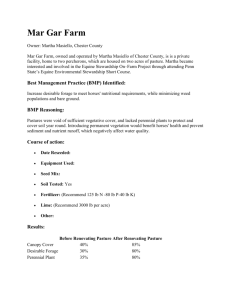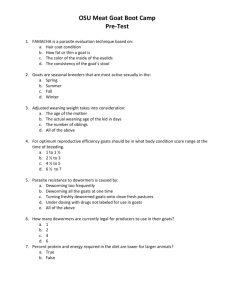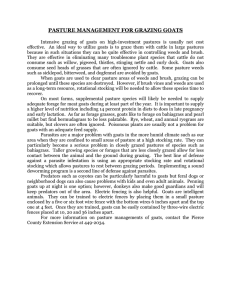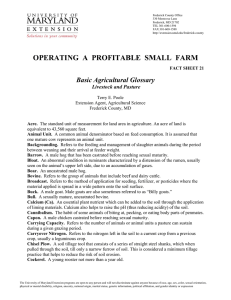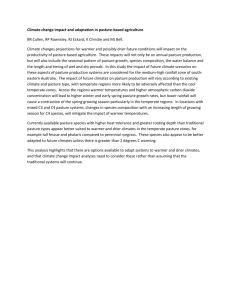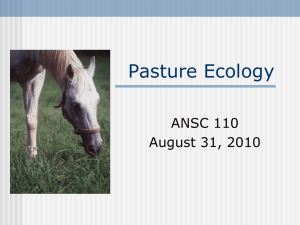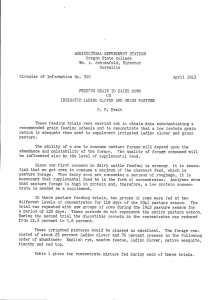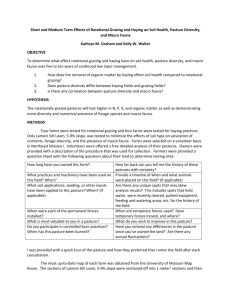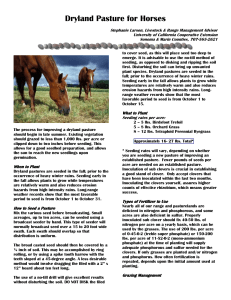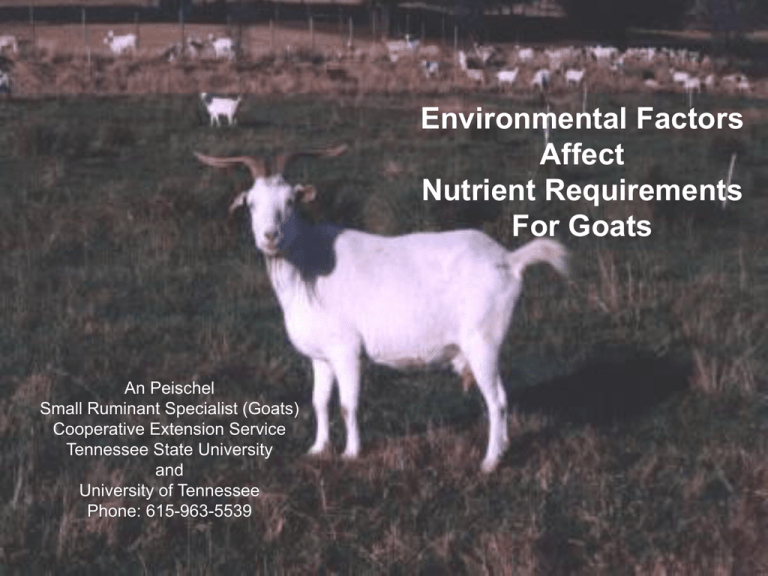
Environmental Factors
Affect
Nutrient Requirements
For Goats
An Peischel
Small Ruminant Specialist (Goats)
Cooperative Extension Service
Tennessee State University
and
University of Tennessee
Phone: 615-963-5539
the GOAT
•
•
•
•
•
•
Environmentally Adaptive
Extremely Opportunistic
Food Security
Biological Land Enhancement
Value-Added Products
Alternative Enterprise
Ecosystem Foundation Blocks
• Succession
– Change and development
– Complex, stable communities
– Competition, interdependence and
adaptation
• Water Cycle
– Maximum use of rainfall
– Minimize erosion
– Percolation / infiltration
Ecosystem Foundation Blocks
• Mineral Cycle
– Effective cyclic pattern
– Biological soil – atmospheric interaction
– Continuous decomposing plant & animal residues
• Energy Flow
–
–
–
–
Carbon cycle
Keeps all processes of life functioning
Solar power
All living things depend upon plants to harvest
(capture) energy from sun & convert it to a useable
form
-INTER · RELATIONSHIPSITEM
Herd
Objectives
Unit Size
Feed on
Offer
Desired
Residual
Growth Rate
Growing
Conditions
Animal
Conditions
Days
Browsed
Days
Grazed
PLANT
ANIMAL
SOIL
ECONOMICS
SOCIAL
the CONTINUUM
• SOIL
• PLANTS
• ANIMALS
• ATMOSPHERE
Healthy Soils
•
•
•
•
•
Drain and warm up quickly in spring
Aeration and permeability maintained
Store moisture for dry spells
Resist erosion and nutrient loss
Support populations of microbes, earthworms, and other
soil life which cycle nutrients and build humus
• Do not require ever-increasing fertilizer rates to maintain high
yields
• Produce healthy, quality forage crops
• Ability to sustain vigorous root systems
The condition of the soil is at least as important as its fertility
SOIL MINERAL DEFICIENCIES
(Tennessee)
• Copper (Cu)
• Fragile bones
• Low conception rate
• Anemia
Selenium (Se)
White muscle disease
Reproductive failure
Zinc (Zn)
Foot rot
Compromised immune system
GROWTH RATE
(# / AC / DA)
I
II
III
IV
Dormant
WEEKS OF GROWTH
Forage Quality & Goat Requirements
PROTEIN
20
Weanling
CP %
15
Does in Early Lactation
Yearling
Dry and Early Pregnant Does
10
5
0
J-M Luginbuhl
Pasture Veget.
Pasture Mature
Pasture Dead
Forage Quality & Goat Requirements
TDN
Weanling
Does in Early Lactation
80
TDN %
70
Yearling
Dry & Early Pregnant Does
60
50
40
30
Pasture Veget.
Pasture Mature Pasture Dead
J-M Luginbuhl
Energy Physiological Priorities
Energy has the number one effect on reproduction
–
–
–
–
–
–
–
–
Basal metabolism
Activity
Growth
Energy reserves
Pregnancy
Lactation
Energy reserves (milk fat)
Estrus cycle / Initiation of pregnancy
• Hormonal
• Ovulation
– Excess energy reserves
35
T
N
C
(%)
30
25
20
15
Mar
Apr May Jun
Jul
Aug Sept
verbina
goldenrod
ironweed
TNC – Lipids, Sugars, Starches, Pectins
Chemical composition of various
plants browsed by goats (%)
Crude
protein
Neutral
detergent
fiber
Multiflora
rose
18.8
34.5
0.99
0.32
Honeysuckle
12.8
34.5
1.21
0.30
Brambles
15.9
24.5
0.23
0.84
Privet
18.0
26.8
0.89
0.34
Green briar
17.0
39.5
0.60
0.18
Kudzu
leaves
23.7
Trumpet
creeper
16.7
43.1
0.42
0.22
Browse type
Calcium
Phosphorous
Goat’s Eye
1)
Young green leaves / stems
70 – 75% digestible
20% CP
24 – 30 hour turn over rate
2)
Old green leaves
60 – 65% digestible
10% CP
50 hour turn over rate
3)
Dead / brown leaves
45% digestible
6% CP
65 hour turn over rate
4)
Mature stems
35% digestible
4% CP
72 hour turn over rate
Body Condition Score (BCS)
BCS 2
BCS 7
Extremely thin
Spinous processes not visible
Spine and ribs visible
Frame not visible
Sternum protruding
Sternum covered
Skin on bone
Hooks and pins rounded
“V” cavity at tailhead
Flat between hooks
Browsing Calendar
(based on the goat)
Specie
Preferred Time
Not
Preferred
Notes
Yellow Star
Thistle
Leaf phase through
seedhead production
Cane heads are
dead & empty
All ages & classes select
1st at various growth
phases
Scotch
Broom
Before flowering
All fall die back
Flowering
Caution using young
doelings & pregnant does
Chamise
Fall / winter / spring
Mid to late summer
Buckeye
Fall as leaves die
Back & seeds drop
Green & productive
Toxic
Tamarisk
New shoots,
Young branches
Old decayed plants
Continuously barking &
trampling
•Fertility
•Moisture
•Organic Matter
•Management
•Terrain
•Physiological state
•Climate
Energy
Requirement
of Goats
Soil
Behavior
•Quantity
•Residual
•Dung and urine
•Grass
•Browse
Vegetation
•Browse
•Density
•Plant part
•Chemical composition
Dietary
Preference
•Plant specie
•Fiber composition
•Nitrogen content
•Seasonal patterns
•Browse and grass
Quality
Factors Affecting Rate of Improvement from Selection
Heritability
Genetic
correlation
Generation
interval
Environmental Factors
South Island of New Zealand
Environmental Factors
Nutrition
• Energy and protein levels in balance to reflect stage of
production
• Vitamin and mineral requirements are being met
–
–
–
–
–
–
Environment / weather
Breed
Stage of production
Quality of diet
Age and sex of goats
Body weight and
body condition
– Activity and exercise
ENVIRONMENTAL STRESS
• Heat and Cold
• Weather (precipitation and humidity)
• Nutrient density
• Quality of feed on offer
• Predation
• Travel (activity)
• Topography
DEGREE of STRESS
(affected by)
•Breed of small ruminant
•Physiological state
•Age / Body size / Sex
•Nutritional status
•Social dominance
•Fight / flight distance
ECONOMIC LO$$
• Decreased reproductive performance of
both males and females
• Inability to maintain body condition score
• Decreased growth rate of off-spring
• Increased incidences of internal parasitism
• Suppressed immune system
Maintain Thermal Balance
• Thermal Radiation
• Humidity
• Air Movement
• Contact Surfaces
• Precipitation
Major Effects of THERMAL STRESS
on Nutrient Requirements
•
•
•
•
•
Reduction in voluntary feed intake
Digestibility and energy metabolism lowered
Increased water consumption
Mineral requirements shift – K and Na
Forage quality decreases
Major Effects of THERMAL STRESS
on Reproduction
•
•
•
•
•
•
Delayed puberty (male and female)
Lower semen quality
Conception rate lowered
Adverse effects on fetal growth
Decrease of birth weights and weaning weights
Increase in number of abortions
Management to Minimize Stress
–
–
–
–
–
–
–
–
Vegetation – browse, pasture, woodlands
Mineral(s) and sea kelp on offer
Nutrient deficiencies corrected
Health (disease prevention, foot problems
controlled, internal parasites minimized)
Facilities / Fencing
Dogs – guardian / herding
Behavior
Water
Cooperative Extension Program

